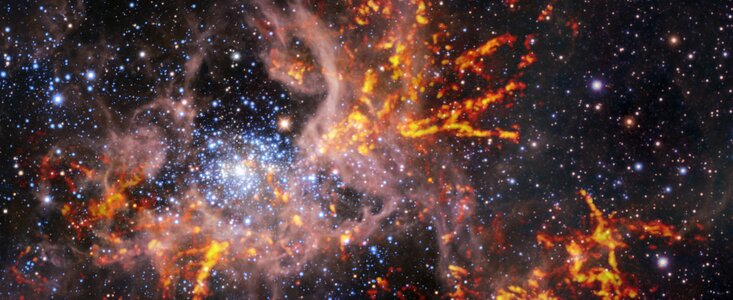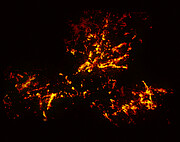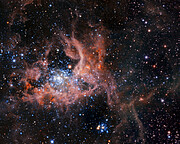Persbericht
Het kosmische web van de Tarantula: astronomen brengen heftige stervorming in kaart in nevel buiten onze Melkweg
15 juni 2022
Astronomen hebben met behulp van de ALMA-telescopen nieuwe details onthuld over het stervormingsgebied 30 Doradus, ook wel bekend als de Tarantulanevel. De Europese Zuidelijke Sterrenwacht (ESO) publiceert vandaag afbeeldingen in hoge resolutie waarin we de nevel in nieuw licht zien. De ijle gaswolken bieden inzicht in hoe in dit gebied zware sterren vormkrijgen.
“Deze fragmenten kunnen overblijfselen zijn van grotere wolken die uit elkaar getrokken zijn door de enorme energieën van jonge, zware sterren. Dat proces wordt ook wel feedback of terugkoppeling genoemd,” zegt Tong Wong. Hij leidde het onderzoek, publiceerde met zijn team in The Astrophysical Journal en presenteerde de afbeeldingen vandaag op een bijeenkomst van de American Astronomical Society (AAS).
Sterrenkundigen dachten vroeger dat de zwaartekracht geen vat op het ijle, turbulente gas kon krijgen. Het gas, zo was het idee, kon niet worden samengebracht en kon geen nieuwe sterren vormen. Maar de nieuwe gegevens laten zien dat er dichte gasgordijnen bestaan waar de zwaartekracht wel een rol speelt. “Onze resultaten impliceren dat zelfs als er heel sterke feedback is, de zwaartekracht toch veel invloed kan uitoefenen en dat de stervorming toch kan doorgaan,” zegt Wong, die hoogleraar is aan de University of Illinois bij Urbana-Champaign, Verenigde Staten.
De Tarantulanevel bevindt zich midden in de Grote Magelhaense Wolk, een satellietstelsel van onze Melkweg. Het is een van de helderste en meest actieve stervormingsregio’s. De nevel bevindt zich op slechts 170.000 lichtjaar van ons vandaan. In het centrum van de nevel bevinden zich enkele van de zwaarste sterren die we kennen. Sommigen zijn 150 keer zo zwaar als onze zon. De regio is een perfecte plek om te onderzoeken hoe gaswolken onder de invloed van de zwaartekracht in elkaar zakken en nieuwe sterren vormen.
"Wat 30 Doradus zo uniek maakt, is dat het dichtbij genoeg is om stervorming in detail te bestuderen. Tegelijkertijd heeft het eigenschappen die lijken op verre sterrenstelsels uit de tijd dat het heelal nog jong was,” zegt Guido De Marchi, een wetenschapper van het Europese ruimteagentschap ESA, en mede-auteur van de wetenschappelijke paper waar het onderzoek in verschijnt. “Dankzij 30 Doradus kunnen we bestuderen hoe sterren zich vormden 10 miljard jaar geleden, toen de meeste sterren werden geboren."
Eerdere studies van de Tarantulanevel richtten zich meestal op het centrum, al weten onderzoekers al langer dat de vorming van zware sterren ook op andere plekken gebeurt. Om het stervormingsproces beter te begrijpen, deed het onderzoeksteam waarnemingen in hoge resolutie aan een groot gebied van de nevel. Ze gebruikten ALMA en maten de emissie van licht van koolmonoxide-gas. Daardoor konden ze grote, koude gaswolken in de nevel in kaart brengen die bezweken en waar nieuwe sterren gevormd werden. Ook konden ze zien hoe het gebied veranderde als er veel energie vrijkomt bij deze jonge sterren.
“We hadden verwacht dat in de delen van de wolk die zich het dichtst bij jonge, zware sterren bevinden, de duidelijkste signalen zouden vertonen van zwaartekracht die onderdrukt werd door feedback,” zegt Wong. “Maar we vinden juist dat de zwaartekracht daar nog steeds belangrijk is, in ieder geval voor delen van de wolk die een voldoende hoge dichtheid hebben.”
In de afbeelding die vandaag door ESO is vrijgegeven, zien we de nieuwe ALMA-gegevens gelegd over een eerdere infraroodafbeelding van hetzelfde gebied. Er zijn heldere sterren zichtbaar en lichtroze wolken van heet gas. De infraroodafbeelding is gemaakt met ESO’s Very Large Telescope (VLT) en met ESO’s Visible and Infrared Survey Telescope for Astronomy (VISTA).
De samengestelde afbeelding toont een duidelijke, spinnenwebachtige vorm van de gaswolken waaraan de Tarantulanevel zijn naam ontleent. De nieuwe ALMA-gegevens bevatten heldere roodgele strepen. Dat is erg koud en dicht gas dat mogelijk op een dag in elkaar stort en nieuwe sterren vormt.
Het nieuwe onderzoek bevat dan wel gedetailleerde aanwijzingen over hoe zwaartekracht zich gedraagt in de stervormingsregio’s van de Tarantulanevel, maar het werk is nog lang niet klaar. “Er is nog veel informatie uit deze fantastische dataset te halen. We openbaren de gegevens zodat andere wetenschappers ook onderzoek kunnen doen,” besluit Wong.
Meer informatie
Het onderzoek wordt gepresenteerd op de 240ste bijeenkomst van de American Astronomical Society (AAS) tijdens een persconferentie met de titel "Stars, Their Environments & Their Planets” (Woensdag, 15 juni, 19.15 uur CEST / 10.15 uur PT). Verslaggevers kunnen de livestream bekijken via het YouTube-kanaal van de AAS Press Office: https://www.youtube.com/c/AASPressOffice.
Het onderzoek staat ook in de wetenschappelijke publicatie “The 30 Doradus Molecular Cloud at 0.4 Parsec Resolution with ALMA: Physical Properties and the Boundedness of CO Emitting Structures” die verschijnt in The Astrophysical Journal.
Het team bestaat uit T. Wong (Astronomy Department, University of Illinois, USA [Illinois]), L. Oudshoorn (Leiden Observatory, Leiden University, The Netherlands [Leiden]), E. Sofovich (Illinois), A. Green (Illinois), C. Shah (Illinois), R. Indebetouw (Department of Astronomy, University of Virginia, USA and National Radio Astronomy Observatory, USA [NRAO]), M. Meixner (SOFIA-USRA, NASA Ames Research Center, USA), A. Hacar (Department of Astrophysics, University of Vienna, Austria), O. Nayak (Space Telescope Science Institute, USA [STSci]), K. Tokuda (Department of Earth and Planetary Sciences, Faculty of Sciences, Kyushu University, Japan and National Astronomical Observatory of Japan, National Institutes of Natural Sciences, Japan and Department of Physics, Graduate School of Science, Osaka Metropolitan University, Japan [Osaka]), A. D. Bolatto (Department of Astronomy and Joint Space Science Institute, University of Maryland, USA and NRAO Visiting Astronomer), M. Chevance (Astronomisches Rechen-Institut, Zentrum für Astronomie der Universität Heidelberg, Germany), G. De Marchi (European Space Research and Technology Centre, Netherlands), Y. Fukui (Department of Physics, Nagoya University, Japan), A. S. Hirschauer (STSci), K. E. Jameson (CSIRO, Space and Astronomy, Australia), V. Kalari (International Gemini Observatory, NSF’s NOIRLab, Chile), V. Lebouteiller (AIM, CEA, CNRS, Université Paris-Saclay, Université Paris Diderot, France), L. W. Looney (Illinois), S. C. Madden (Departement d’Astrophysique AIM/CEA Saclay, France), Toshikazu Onishi (Osaka), J. Roman-Duval (STSci), M. Rubio (Departamento de Astronomía, Universidad de Chile, Chile) and A. G. G. M. Tielens (Department of Astronomy, University of Maryland, USA and Leiden).
De Europese Zuidelijke Sterrenwacht (ESO) stelt wetenschappers van over de hele wereld in staat om de geheimen van het heelal te ontdekken, ten bate van iedereen. Wij ontwerpen, bouwen en exploiteren observatoria van wereldklasse die door astronomen worden gebruikt om spannende vragen te beantwoorden en de fascinatie voor astronomie te verspreiden, en bevorderen internationale samenwerking op het gebied van de astronomie. ESO, in 1962 opgericht als intergouvernementele organisatie, wordt inmiddels gedragen door 16 lidstaten (België, Denemarken, Duitsland, Finland, Frankrijk, Ierland, Italië, Nederland, Oostenrijk, Polen, Portugal, Spanje, Tsjechië, het Verenigd Koninkrijk, Zweden en Zwitserland) en door het gastland Chili, met Australië als strategische partner. Het hoofdkwartier van de ESO en haar bezoekerscentrum en planetarium, de ESO Supernova, zijn gevestigd nabij München in Duitsland, maar onze telescopen staan opgesteld in de Chileense Atacama-woestijn – een prachtige plek met unieke omstandigheden voor het doen van hemelwaarnemingen. ESO exploiteert drie waarnemingslocaties: La Silla, Paranal en Chajnantor. Op Paranal staan ESO’s Very Large Telescope en Very Large Telescope Interferometer, evenals twee surveytelescopen: VISTA voor infrarood en de VST voor zichtbaar licht. Op Paranal zal de ESO ook de Cherenkov Telescope Array South huisvesten en exploiteren – ’s werelds grootste en gevoeligste observatorium van gammastraling. Samen met internationale partners beheert ESO APEX en ALMA op Chajnantor, twee faciliteiten die de hemel waarnemen in het millimeter- en submillimetergebied. Op Cerro Armazones, nabij Paranal, bouwen wij ‘het grootste oog ter wereld’ – ESO’s Extremely Large Telescope. Vanuit onze kantoren in Santiago, Chili, ondersteunen wij onze activiteiten in het gastland en werken wij samen met Chileense partners en de Chileense samenleving
De Atacama Large Millimeter/submillimeter Array (ALMA), een internationale astronomische faciliteit, is een samenwerkingsverband van ESO, de Amerikaanse National Science Foundation (NSF) en de National Institutes of Natural Sciences (NINS) van Japan, in samenwerking met de Republiek Chili. ALMA wordt gefinancierd door ESO (namens haar lidstaten), door de NSF in samenwerking met de National Research Council of Canada (NRC) en de National Science Council of Taiwan (NSC), en door NINS in samenwerking met de Academia Sinica (AS) in Taiwan en het Korea Astronomy and Space Science Institute (KASI). De bouw en het beheer van ALMA worden geleid door ESO (namens haar lidstaten); door het National Radio Astronomy Observatory (NRAO), dat namens Noord-Amerika wordt bestuurd door de Associated Universities, Inc. (AUI), en namens Oost-Azië door het National Astronomical Observatory of Japan (NAOJ). De overkoepelende leiding en het toezicht op bouw, ingebruikname en beheer van ALMA is in handen van het Joint ALMA Observatory (JAO).
Links
- Wetenschappelijke publicatie
- NRAO-persbericht
- Foto’s van ALMA
- Foto’s van VISTA
- Foto’s van de VLT
- Andere beelden van de Tarantulanevel Tarantula Nebula
- Voor journalisten: abonneer je op persberichten in je eigen taal
- Voor wetenschappers: heb je een verhaal? Promoot je onderzoek
Contact
Tony Wong
Astronomy Department, University of Illinois
Urbana-Champaign, IL, USA
Tel: +1 217 244 4207
E-mail: wongt@illinois.edu
Guido De Marchi
European Space Research and Technology Centre, European Space Agency
Noordwijk, Netherlands
Tel: +31 71 565 8332
Mob: +31 6 5081 6906
E-mail: gdemarchi@esa.int
Bárbara Ferreira
ESO Media Manager
Garching bei München, Germany
Tel: +49 89 3200 6670
Mob: +49 151 241 664 00
E-mail: press@eso.org
Rodrigo Alvarez (press contact België)
ESO Science Outreach Network
en Planetarium, Royal Observatory of Belgium
Tel: +32-2-474 70 50
E-mail: eson-belgië@eso.org
Over dit bericht
| Persberichten nr.: | eso2209nl-be |
| Naam: | 30 Doradus, Tarantula Nebula |
| Type: | Local Universe : Nebula : Type : Star Formation |
| Facility: | Atacama Large Millimeter/submillimeter Array |
| Science data: | 2022ApJ...932...47W |
Our use of Cookies
We use cookies that are essential for accessing our websites and using our services. We also use cookies to analyse, measure and improve our websites’ performance, to enable content sharing via social media and to display media content hosted on third-party platforms.
ESO Cookies Policy
The European Organisation for Astronomical Research in the Southern Hemisphere (ESO) is the pre-eminent intergovernmental science and technology organisation in astronomy. It carries out an ambitious programme focused on the design, construction and operation of powerful ground-based observing facilities for astronomy.
This Cookies Policy is intended to provide clarity by outlining the cookies used on the ESO public websites, their functions, the options you have for controlling them, and the ways you can contact us for additional details.
What are cookies?
Cookies are small pieces of data stored on your device by websites you visit. They serve various purposes, such as remembering login credentials and preferences and enhance your browsing experience.
Categories of cookies we use
Essential cookies (always active): These cookies are strictly necessary for the proper functioning of our website. Without these cookies, the website cannot operate correctly, and certain services, such as logging in or accessing secure areas, may not be available; because they are essential for the website’s operation, they cannot be disabled.
Functional Cookies: These cookies enhance your browsing experience by enabling additional features and personalization, such as remembering your preferences and settings. While not strictly necessary for the website to function, they improve usability and convenience; these cookies are only placed if you provide your consent.
Analytics cookies: These cookies collect information about how visitors interact with our website, such as which pages are visited most often and how users navigate the site. This data helps us improve website performance, optimize content, and enhance the user experience; these cookies are only placed if you provide your consent. We use the following analytics cookies.
Matomo Cookies:
This website uses Matomo (formerly Piwik), an open source software which enables the statistical analysis of website visits. Matomo uses cookies (text files) which are saved on your computer and which allow us to analyze how you use our website. The website user information generated by the cookies will only be saved on the servers of our IT Department. We use this information to analyze www.eso.org visits and to prepare reports on website activities. These data will not be disclosed to third parties.
On behalf of ESO, Matomo will use this information for the purpose of evaluating your use of the website, compiling reports on website activity and providing other services relating to website activity and internet usage.
Matomo cookies settings:
Additional Third-party cookies on ESO websites: some of our pages display content from external providers, e.g. YouTube.
Such third-party services are outside of ESO control and may, at any time, change their terms of service, use of cookies, etc.
YouTube: Some videos on the ESO website are embedded from ESO’s official YouTube channel. We have enabled YouTube’s privacy-enhanced mode, meaning that no cookies are set unless the user actively clicks on the video to play it. Additionally, in this mode, YouTube does not store any personally identifiable cookie data for embedded video playbacks. For more details, please refer to YouTube’s embedding videos information page.
Cookies can also be classified based on the following elements.
Regarding the domain, there are:
- First-party cookies, set by the website you are currently visiting. They are stored by the same domain that you are browsing and are used to enhance your experience on that site;
- Third-party cookies, set by a domain other than the one you are currently visiting.
As for their duration, cookies can be:
- Browser-session cookies, which are deleted when the user closes the browser;
- Stored cookies, which stay on the user's device for a predetermined period of time.
How to manage cookies
Cookie settings: You can modify your cookie choices for the ESO webpages at any time by clicking on the link Cookie settings at the bottom of any page.
In your browser: If you wish to delete cookies or instruct your browser to delete or block cookies by default, please visit the help pages of your browser:
Please be aware that if you delete or decline cookies, certain functionalities of our website may be not be available and your browsing experience may be affected.
You can set most browsers to prevent any cookies being placed on your device, but you may then have to manually adjust some preferences every time you visit a site/page. And some services and functionalities may not work properly at all (e.g. profile logging-in, shop check out).
Updates to the ESO Cookies Policy
The ESO Cookies Policy may be subject to future updates, which will be made available on this page.
Additional information
For any queries related to cookies, please contact: pdprATesoDOTorg.
As ESO public webpages are managed by our Department of Communication, your questions will be dealt with the support of the said Department.






